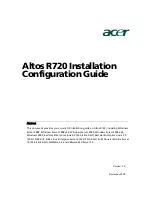
CAUTION:
To change the storage volume, shadow copies must be deleted. The existing file change history that is kept
on the original storage volume is lost. To avoid this problem, verify that the storage volume that is initially
selected is large enough.
Identifying the storage area
To store the shadow copies of another volume on the same file server, a volume can be dedicated
on separate disks. For example, if user files are stored on
H:\
, another volume such as
S:\
can be
used to store the shadow copies. Using a separate volume on separate disks provides better
performance and is recommended for heavily used storage servers.
If a separate volume will be used for the storage area (where shadow copies are stored), the maximum
size should be changed to
No Limit
to reflect the space available on the storage area volume instead
of the source volume (where the user files are stored).
Disk space for shadow copies can be allocated on either the same volume as the source files or a
different volume. There is a trade-off between ease of use and maintenance versus performance and
reliability that the system administrator must consider.
By keeping the shadow copy on the same volume, there is a potential gain in ease of setup and
maintenance; however, there may be a reduction in performance and reliability.
CAUTION:
If shadow copies are stored on the same volume as the user files, note that a burst of disk input/output
(I/O) can cause all shadow copies to be deleted. If the sudden deletion of shadow copies is unacceptable
to administrators or end users, it is best to use a separate volume on separate disks to store shadow copies.
Determining creation frequency
The more frequently shadow copies are created, the more likely that end users will get the version
that they want. However, with a maximum of 64 shadow copies per volume, there is a trade-off
between the frequency of making shadow copies and the amount of time that the earlier files will be
available.
By default, the storage server creates shadow copies at 0700 and 1200, Monday through Friday.
However, these settings are easily modified by the administrator so that the shadow copy schedule
can better accommodate end user needs.
Shadow copies and drive defragmentation
When running Disk Defragmenter on a volume with shadow copies activated, all or some of the
shadow copies may be lost, starting with the oldest shadow copies.
If defragmenting volumes on which shadow copies are enabled, use a cluster (or allocation unit) size
of 16 KB or larger. Using this allocation unit size reduces the number of copy outs occurring on the
snapshot. Otherwise, the number of changes caused by the defragmentation process can cause
shadow copies to be deleted faster than expected. Note, however, that NTFS compression is supported
only if the cluster size is 4 KB or smaller.
HP ProLiant Storage Server
69
Содержание ML110 - ProLiant G5 2TB Storage Server NAS
Страница 1: ...HP ProLiant Storage Server user guide Part number 440584 004 First edition February 2008 ...
Страница 50: ...Server components 50 ...
Страница 92: ...File server management 92 ...
Страница 110: ...Microsoft Services for Network File System MSNFS 110 ...
Страница 150: ...Troubleshooting servicing and maintenance 150 ...
Страница 152: ...System recovery 152 ...
Страница 158: ...BSMI notice Japanese notice Korean notice A B Class A equipment Class B equipment Regulatory compliance and safety 158 ...
Страница 172: ...Index 172 ...
















































